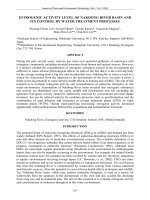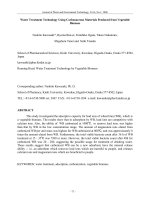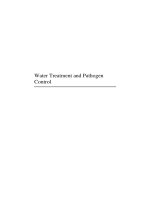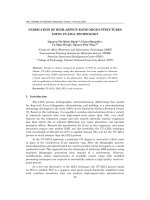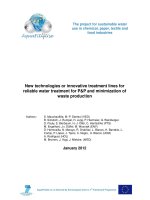Ballast water treatment using electrochemical disinfection technology
Bạn đang xem bản rút gọn của tài liệu. Xem và tải ngay bản đầy đủ của tài liệu tại đây (2.86 MB, 234 trang )
BALLAST WATER TREATMENT USING ELECTROCHEMICAL
DISINFECTION TECHNOLOGY
K.G. NADEESHANI NANAYAKKARA
NATIONAL UNIVERSITY OF SINGAPORE
2010
BALLAST WATER TREATMENT USING ELECTROCHEMICAL
DISINFECION TECHNOLOGY
K.G. NADEESHANI NANAYAKKARA
(B.Sc (Eng), Hons., University of Peradeniya)
A THESIS SUBMITTED
FOR THE DEGREE OF DOCTOR OF PHILOSOPHY
DIVISION OF ENVIRONMENTAL SCIENCE AND ENGINEERING
NATIONAL UNIVERSITY OF SINGAPORE
2010
ACKNOWLEDGEMENT
I would like to express my gratitude to everyone who has supported me to
complete the doctoral studies.
First of all, I am deeply thankful to my supervisor, Associate Professor J. Paul
Chen, for his endless support during the four years of my studies. His expertise in
environmental science and engineering shaped my research and me, as a researcher.
Professor Chen’s guidance and encouragement was a great help during the entire
course of study.
Further, I am grateful to Professor Ng Wun Jern and Dr. Induka Werellagama for
their guidance when I was applying for the doctoral studies at the National University
of Singapore.
My sincere gratitude to all my research group members including Dr. Zheng
Yuming, Dr. Lim Soh Fong, Dr. Zhao Deqiang, Mr. Zou Shuaiwen, Ms. Rita Farida
Yunus, Ms. Wei Yuting, Mr. Ma Yue, and Ms. Han Yi Tay for their support, views,
and friendliness throughout this period.
I also wish to thank the laboratory staffs, especially Ms. Susan Chia and Ms. Mary
Chong, of the Division of Environmental Science and Engineering at the National
University of Singapore, for their help in laboratory work.
i
Then, it is my family, whom I should thanks for giving me love, care, and
encouragement. I am deeply grateful to my father Anesly Nanayakkara and late mother
Rohini Nanayakkara, as well as my step-mother Jayanthi Nanayakkara. I always
believe my late mother’s wishes make me who I am today. Then, my gratefulness is
to my beloved husband, Pradeep Karunarathne, for his everlasting love, trust, patience,
and care. I strongly believe, if he is not with me, I wouldn’t have come this far. Thanks
for bearing my stress and looking after me all this while. Sorry if I was not a good wife
during these four years. Next, it is my loving sister, Madurika Nanayakkara, who
emotionally encouraged me throughout my life. I am sincerely thankful to my late
grand parents, Simon Perera and Rupawathi Perera, and my uncles, aunts, and cousins,
who helped me during the bad days of my life. Next, my gratitude is to my
parents-in-law and the family, who encouraged me all this while.
I would like to appreciate the government and people of Sri Lanka for giving me
free education from Grade 1 until I finished my first degree at the University of
Peradeniya, Sri Lanka.
The financial support from the National University of Singapore is greatly respected.
Without the support of the full research scholarship, my desire to pursue doctoral study
may not have been realized.
Nadeeshani Nanayakkara
ii
TABLE OF CONTENTS
Page
ACKNOWLEDGEMENT
i
TABLE OF CONTENTS
iii
SUMMARY
x
LIST OF TABLES
xiii
LIST OF FIGURES
xvi
LIST OF SYMBOLS
xxv
CHAPTER 1: INTRODUCTION
1
1.1. Ballast water and the ocean environment 2
1.2. Technologies been researched 4
1.3. Objectives and scopes 7
CHAPTER 2: LITERATURE REVIEW
10
2.1. Biological invasion 10
2.1.1. Invasion through ballast water and sediment 10
2.1.2. Invasion through “No ballast on board” ships 16
2.2. Regulations for ballast water management 17
2.2.1.Regulations adopted by the IMO 17
2.2.1.1. Ballast water exchange 21
2.2.1.2. Timeline for implementation of the ballast water
management plan
24
iii
2.3. Treatment technologies 25
2.3.1. Primary treatment systems 27
2.3.2. Secondary treatment systems 29
2.3.2.1. Thermal treatment 29
2.3.2.2. Deoxygenation treatment 32
2.3.2.3. Chemical Biocide treatment 33
2.3.2.4. Electrolysis 36
2.3.2.5. Ultrasonic treatment 37
2.3.3. Combination of primary and secondary treatment systems 38
2.3.4. Other researched treatment options 43
2.4. Electrochemical disinfection 44
2.4.1. Fundamentals of electrochemical disinfection 44
2.4.2. Examples of electrochemical disinfection 47
2.4.3. Mechanism studies of electrochemical disinfection 50
2.4.4. Selection of electrodes for electrochemical disinfection 52
CHAPTER 3: MATERIALS AND METHODS
54
3.1. Materials 54
3.2. Study of the electrochemical disinfection reactor 55
3.2.1. Culture preparation 55
3.2.2. Enumeration of bacteria 55
3.2.3. Preliminary study for electrochemical disinfection 56
3.2.4. Determination of the flow condition in the reactor 56
iv
3.2.5. Electrochemical disinfection reactor operation 57
3.2.6. Kinetics of disinfection of E. coli and E. faecalis 58
3.2.7. Scanning electron microscope (SEM) study of E. coli 60
3.2.8. Experiment design for the reactor optimization 60
3.2.9. Study of residual disinfection effect 61
3.2.10. Pilot scale electrochemical disinfection setup 62
3.3. Other disinfection technologies 63
3.3.1. Ultrasonic disinfection 63
3.3.2. Disinfection using heating 64
3.3.3. Deoxygenation using Nitrogen bubbling 64
3.4. Detection of disinfectants 64
3.4.1. Determination of chlorine concentration 64
3.4.2. Determination of ozone concentration 65
3.4.3. Qualitative analysis of hydroxyl (OH
•
) radical 65
3.4.4. Use of OH
•
radical scavenger 66
3.5. Preparation and characterization of RuO
2
coated Ti mesh electrode 66
3.5.1. Preparation of RuO
2
coated Ti mesh electrode 66
3.5.2. Cyclic voltammetry 67
3.5.3. Chlorine production at constant voltage 68
3.5.4. Accelerated lifetime test 68
3.5.5. Open circuit potential 68
3.5.6. VA computrace study 69
v
3.5.7. Scanning electron microscopy and energy-dispersive X-ray
spectroscopy studies
69
3.5.8. Batch experiments 70
CHAPTER 4: DEVELOPMENT AND OPTIMIZATION OF
ELECTROCHEMICAL DISINFECTION REACTOR
71
4.1. Preliminary disinfection studies 71
4.1.1. Ultrasonic disinfection 71
4.1.2. Disinfection using Heating 73
4.1.3. Disinfection using deoxygenation 73
4.1.4. Preliminary study on electrochemical disinfection 76
4.1.4.1. Effect of HRT and I
d
on the disinfection efficiency 76
4.1.4.2. Effect of energy consumption 77
4.1.4.3. Total residual chlorine production vs. HRT 78
4.2. Electrochemical reactor development and optimization 80
4.2.1. Electrochemical reactor design 80
4.2.2. Stability of the reactor performances over time 83
4.2.3. Optimization of the electrochemical reactor for disinfection of
E. coli
85
4.2.3.1. Design of experiments 85
4.2.3.2. Analysis and Optimization 87
4.2.4. Effect of number of electrodes 91
4.2.5. Residual disinfection capability of the electrochemical 93
vi
disinfection system
4.2.6. Utilization of the electrochemical reactor for disinfection of E.
faecalis
95
4.3. Pilot scale study 98
4.3.1. Chlorine production experiments 98
4.3.2 Disinfection of E. coli using the pilot scale reactor system 103
4.3.3 Disinfection of E. faecalis using the pilot scale reactor system 104
CHAPTER 5: MODELLING STUDY OF THE KINETICS OF
DISINFCTION USING THE DEVELOPED ELECTROCHEMICAL
TECHNOLOGY
107
5.1. Kinetics of disinfection of E. coli 107
5.1.1 Disinfection performance of the electrochemical reactor 107
5.1.2. Major mechanism(s) of disinfection 110
5.1.3. Chlorine decay 115
5.1.4. Kinetics of disinfection 118
5.2. Kinetics of disinfection of E. faecalis 124
CHAPTER 6: DEVELOPMENT AND CHARACTERIZATION OF
ELECTRODES FOR ELECTROCHEMICAL DISINFECTION
130
6.1. Preliminary work on electrode material selection 130
6.1.1. Iron plates 130
6.1.2. Stainless steel plates 132
6.1.3. Titanium plates 132
vii
6.1.4. Comparison between Ti mesh electrode used in developed
reactor and commercial Ti mesh electrode coated with RuO
2
as one of the
components
134
6.2. Development, characterization, and utilization of RuO
2
coated Ti
mesh anode
138
6.2.1. SEM/EDX analysis of prepared electrodes 138
6.2.2. Cyclic voltammetry analysis of prepared electrodes 140
6.2.3. Chlorine production at constant current 143
6.2.4. Chlorine production at constant voltage 148
6.2.5. Accelerated lifetime of electrodes 152
6.2.6. Open circuit potential 154
6.2.7. VA computrace study 157
6.2.8. Utilization of prepared electrode in long-term chlorine
production
158
6.2.9. Utilization of prepared electrode in disinfection 161
CHAPTER 7: GENERATION OF DISINFECTANTS USING RuO
2
COATED AND UNCOATED Ti MESH (BENCH SCALE) ANODES
AND DISINFECTION BEHAVIOR
164
7.1. Properties of the RuO
2
coated Ti mesh and Ti mesh used in bench
scale study
164
7.2. Disinfection performance in seawater electrolyte- role of
electrochemically generated chlorine
167
viii
7.3. Disinfection study in Na
3
PO
4
electrolyte- effect of chloride free
solution
170
7.3.1. Efficiency of disinfection 170
7.3.2. Role of ozone 173
7.3.3. Role of OH
•
radical 174
7.3.3.1. Qualitative detection of OH
•
radical 175
7.3.3.2. Disinfection study with iso-propanol as radical scavenger 178
7.4. Effect of salt (chloride free) on disinfection 180
CHAPTER 8: CONCLUSIONS AND RECCOMONDATIONS
184
8.1. Conclusions 184
8.2. Recommendations 187
REFERENCES
189
PUBLICATIONS
205
ix
SUMMARY
Electrochemical disinfection of E. coli and E. faecalis in ballast water (BW) was
studied. Electrochemical disinfection reactor was designed and fabricated. Operating
parameters were optimized and the reactor was successfully tested in laboratory and
pilot scales. Disinfection kinetics was modeled. Rare metal oxide coated electrode was
developed, characterized, and successfully incorporated in generation of oxidants.
Mechanisms of electrochemical disinfection under various conditions were studied.
An electrochemical disinfector was developed and optimized for the purpose of
BW disinfection. The reactor dimensions were carefully selected such that the flow
condition inside the reactor was closer to a plug flow. Ti mesh electrodes were
employed in the reactor. It was found that E. coli can be treated (to reach the
International Maritime Organization’s (IMO) regulation) within a hydraulic retention
time (HRT) of 30 second and the corresponding energy input was as low as 0.004
kWh/m
3
of BW. Total residual chlorine concentration was as low as 1 mg/L.
Disinfection of E. faecalis showed that the extension of contact time was needed. The
electrochemically treated BW was stored in the ballast tank with a total residual
chlorine concentration of 2 – 3 mg/L in order to disinfect E. faecalis to IMO regulated
value. The required contact time was about 2 h. The residual chlorine concentration
dropped to 1.5 mg/L after 24 h. These laboratory scale findings were further confirmed
in pilot scale reactor system with a treatment capacity of 12m
3
/h.
x
Kinetics of disinfection of E. coli and E. faecalis were modeled based on the mass
balance concept. Factors such as major disinfection mechanism and effect of chlorine
decay were incorporated in the modeling. Different initial populations of bacteria were
investigated. It was found that the time to achieve IMO regulation varied with the
initial bacterial population. For example, at initial E. coli concentrations of 10
7
CFU/100ml and 10
6
CFU/100ml, HRT required for complete removal of bacteria were
120 s and 60 s, respectively. Hence, the kinetic constants were varied according to the
initial concentration of bacteria in the solution. Variations in chlorine demand for
different levels of bacteria concentration was identified as the possible reason for the
above finding.
Electrodes, especially anodes, are of crucial importance at the point of real
application. A rare metal oxide was coated on Ti mesh to produce an electrode (anode)
which was capable of generating chlorine with high current efficiency and good
stability. Sol-gel procedure was used in the preparation of electrode. The electrode
prepared with sols aged for 18 h was found to be the best electrode in terms of chlorine
production and stability. Although the electrode prepared using sols aged for 24 h
showed the highest electro-active area, it produced less chlorine than the electrode
prepared with sols aged for 18 h. Electrode prepared with sols aged for 24 h found to
be more prone to corrosion and this may have caused some chlorine demand and thus
the measured chlorine concentration was lower. The prepared electrode showed a good
stability in seawater electrolysis and was tested successfully in disinfection operation.
xi
The rare metal oxide coated Ti mesh and the Ti mesh used in the bench scale (and
pilot scale) reactor were studied for their disinfection behaviors under different
conditions. Two electrodes did not show a remarkable difference in seawater
electrolyte in terms of disinfection efficiency, except that the energy consumption was
low at the metal oxide coated Ti mesh provided that the similar geometrical area was
used. However, if the electro-active surface area was considered, the metal oxide
coated Ti mesh electrode outperformed the uncoated Ti mesh. When Na
3
PO
4
was used
as the electrolyte, the metal oxide coated Ti mesh electrode showed significantly high
disinfection efficiency compared to the Ti mesh. It was found that amount of OH
•
radical produced at the metal oxide coated Ti mesh was higher than that of Ti mesh
electrode. Moreover, a study was conducted at different salt electrolytes and was found
that the disinfection mechanism varied according to the electrolyte salt in use.
xii
LIST OF TABLES
TABLE
TITLE PAGE
1.1 Comparison of electrochemical technology with previously
researched technologies
6
2.1 Examples of invasions through ballast water
15
2.2 Ballast water performance standards (IMO Regulation D-2)
18
2.3 Guidelines adopted by IMO Marine Environment Protection
Committee (MEPC) on the “uniform implementation of the
ballast water management convention”
20
2.4 Ballast water management requirements for ships according
to the year of construction
24
2.5 Chemical biocides for ballast water treatment
36
2.6 Ballast water treatment technologies
43
2.7 Oxidation potential of electrochemically generated oxidants
46
4.1 Average and standard deviation values of reactor voltage and
chlorine production
83
4.2 Factors and levels used in the experimental design
85
4.3 Design of experiments for optimization of electrochemical
reactor parameters in E. coli disinfection
86
xiii
4.4 HRT values of the second reactor at different F2 values
93
4.5 Disinfection of E. faecalis using the developed
electrochemical reactor: Preliminary study
95
4.6 Flow rates and corresponding hydraulic retention times used
in the study
100
4.7 Table 4.7: Effect of current on disinfection of E. coli. Test
conditions: Flow rate=12 m
3
/h, Number of electrodes=8,
Initial E. coli concentration ≈10
6
CFU/100ml. Specific
surface area of electrode (based on anode) = 13.34 m
2
/m
3
of
reactor volume
103
4.8 Table 4.8: Effect of flow rate on disinfection of E. coli. Test
conditions: Current=24 A, Number of electrodes=8,
Voltage=3.1 V, Initial E. coli concentration ≈10
6
CFU/100ml.
Specific surface area of electrode (based on anode) = 13.34
m
2
/m
3
of reactor volume
104
4.9 Table 4.9: Disinfection of E. faecalis using the pilot scale
electrochemical disinfection system. Specific surface area of
electrode (based on anode) = 13.34 m
2
/m
3
of reactor volume
105
5.1 Table 5.1: Linear relationships between total residual chlorine
production and HRT for different initial E. coli
concentrations. Specific surface area of electrode (based on
anode) = 13.34 m
2
/m
3
of reactor volume.
109
5.2 Parameters of chlorine decay under different values of t
1
117
5.3 Kinetic parameters and ESS of kinetic modeling for different
initial E. coli concentrations
123
xiv
5.4 Reaction rate and ESS of kinetic modeling for different initial
E. faecalis concentrations
127
5.5 Parameters of chlorine decay modeling at different initial
concentrations of E. faecalis
128
6.1 Production of chlorine using iron plate electrodes
131
6.2 Production of chlorine using stainless steel plate electrodes
132
6.3 Production of chlorine using Ti plate electrodes
133
6.4 Surface composition of commercial electrode
135
6.5 Surface elemental analysis of prepared anodes using EDX
140
6.6 Parameters of linear relationship between chlorine production
and contact time for different electrodes
144
6.7 Linear relationship between experimental and theoretical
chlorine productions for prepared electrodes and related
current efficiency (m) values
147
6.8 Life time of electrodes at accelerated lifetime tests
154
7.1 Surface elemental analysis of electrodes using EDX
166
xv
LIST OF FIGURES
FIGURE
TITLE PAGE
1.1 Invasion pathway of living organisms through the process of
ballast water transport
3
2.1 Mid-Ocean ballast water exchange process
23
2.2 Proposed “Heating” technology as a BW treatment
technology using the waste heat of the ship’s main engine
31
2.3 Proposed UV – based treatment systems with pre-treatment:
(a) Cyclonic pre-treatment with UV irradiation (b) Separator,
filter and UV irradiation
39
2.4 Electrochemical reactors for disinfection of contaminated
fluids (a) batch reactor (b) plug flow reactor (c) continuous
stirred tank reactor
46
3.1 Experimental setup
58
3.2 Experimental setup to study the residual disinfection effect
62
3.3 Schematic diagram of pilot scale system
63
4.1 Ultrasonic disinfection of E. coli (a) Disinfection efficiency
vs. contact time (b) Change in solution temperature vs.
contact time (c) Final E. coli concentration vs. contact time
72
4.2 Disinfection of E. coli using heating at 45
0
C (a) Disinfection
efficiency vs. contact time (b) Final E. coli concentration vs.
contact time
74
xvi
4.3 Disinfection of E. coli using deoxygenation of ballast water
using nitrogen bubbling (a) Disinfection efficiency vs.
contact time (b) Final E. coli concentration vs. contact time
75
4.4 Inactivation efficiency with HRT and current density
76
4.5 Final E. coli concentration vs. hydraulic retention time
77
4.6 Disinfection efficiency vs. energy consumption. Flow rates
were0.15, 0.3, 0.6, and 0.9 L/min at HRTs of 120, 60, 30, and
20 s, respectively.
78
4.7 Total residual chlorine with HRT and current density
79
4.8 Electrochemical disinfection reactor (a) Reactor with Ti mesh
electrodes installed (b) Monopolar electrical connection
81
4.9 Analysis of the flow behavior in the reactor (a) Experimental
results of the designed reactor system (b) Flow pattern for
ideal and non-ideal plug flow
82
4.10 Variations in reactor performance over time (a) Voltage vs.
time of observation (b) Total chlorine production vs. time of
observation. Specific surface area of electrode (based on
anode) = 66.67 m
2
/m
3
of reactor volume
84
4.11 Selection of experimental runs based on the central composite
design
86
4.12 Three dimensional surface plots of electrochemical
disinfection of E. coli in ballast water (a) Disinfection
efficiency vs. HRT and current (b) Final E. coli concentration
vs. HRT and current (c) Total chlorine concentration vs. HRT
89
xvii
and current. Specific surface area of electrode (based on
anode) = 66.67 m
2
/m
3
of reactor volume
4.13 Final E. coli concentration vs. energy consumption (a)
Applied energy < 0.002 kWh/m
3
(b) Applied energy ≥0.004
kWh/m
3
. Specific surface area of electrode (based on anode)
= 66.67 m
2
/m
3
of reactor volume
90
4.14 Effect of number of electrodes on the reactor performances
(a) Disinfection efficiency vs. number of electrodes (b) Total
residual chlorine vs. number of electrodes. (c) Voltage to
reach 0.3 A of current vs. number of electrodes (d) Energy
consumption vs. number of electrodes. Specific surface area
of electrode (based on anode): 3.33, 6.66, 13.34, 26.64, 39.96,
53.28, and 66.67 m
2
/m
3
of reactor volume at 2, 4, 8, 16, 24,
32, and 40 electrodes, respectively.
92
4.15 Residual disinfection capacity of electrochemically treated
water (a) Total residual chlorine concentration vs. flow rate to
the second (untreated) reactor, F2 (b) Disinfection efficiency
vs. F2. Specific surface area of electrode (based on anode) =
13.34 m
2
/m
3
of reactor volume
94
4.16 Cell wall structure of gram positive and gram negative
bacteria
96
4.17 Disinfection of E. faecalis (a) Disinfection efficiency vs.
contact time (b) Final E. faecalis concentration vs. contact
time (c) Total residual chlorine concentration vs. contact
time. Specific surface area of electrode (based on anode) =
13.34 m
2
/m
3
of reactor volume
97
4.18 Effect of current on chlorine production of the pilot scale
reactor system. Specific surface area of electrode (based on
anode) = 13.34 m
2
/m
3
of reactor volume
100
4.19 Effect of flow rate on chlorine production. Specific surface 101
xviii
area of electrode (based on anode) = 13.34 m
2
/m
3
of reactor
volume
4.20 Effect of number of electrodes on system performance.
Specific surface area of electrode (based on anode): 3.33,
6.66, 13.34, 26.64, 49.95, and 99.6 m
2
/m
3
of reactor volume
at 2, 4, 8, 16, 30 and 60 electrodes, respectively.
102
5.1 Disinfection efficiency vs. energy consumption. Specific
surface area of electrode (based on anode) = 13.34 m
2
/m
3
of
reactor volume.
108
5.2 Total residual chlorine concentration vs. HRT for different
initial E. coli concentrations. Specific surface area of
electrode (based on anode) = 13.34 m
2
/m
3
of reactor volume.
108
5.3 Comparison of efficiency of disinfection in seawater
electrolyte and chloride-free electrolyte. Specific surface area
of electrode (based on anode) = 13.34 m
2
/m
3
of reactor
volume
112
5.4 Morphological changes in E. coli (a) after electrochemical
disinfection (0.1 A, 2 min) (b) after chlorination using NaOCl
(total residual chlorine concentration of 2 mg/L for 3 min) (c)
before treatment
114
5.5 Chlorine decay at different levels of initial total chlorine
concentrations
116
5.6 Chlorine decay at different levels of mixing
118
5.7 Reactor model considered in the mass balance analysis for
development of the kinetic model
119
5.8 Kinetic modeling: comparison of observed survival ratios 123
xix
with calculated survival ratios (using model) vs. hydraulic
retention time. Specific surface area of electrode (based on
anode) = 13.34 m
2
/m
3
of reactor volume
5.9 Observed and calculated chlorine decay in electrolyte without
E. faecalis. y
0
= 1.74025 mg/L, A
1
= 1.13804 mg/L, t
1
=
7.65207 h
-1
125
5.10 Kinetic modeling: comparison of observed survival ratios
with calculated survival ratios (using model) vs. contact time.
Specific surface area of electrode (based on anode) = 13.34
m
2
/m
3
of reactor volume
127
5.11 Observed and calculated (model-predicted) chlorine decay at
different initial concentrations of E. faecalis
128
6.1 Corrosion of iron electrodes in electrochemical reactor (a)
Before use in electrolysis (b) After use for electrolysis
131
6.2 Damages to the Ti anode during electrolysis (a) Before use
(b) After use)
133
6.3 Ti mesh electrodes after two days of continuous operation (a)
Anode (b) Cathode
134
6.4 Variation in voltage during the 8 days of continuous operation
135
6.5 SEM images of the commercial electrodes. (a) anode used for
8 days, (b) cathode used for 8 days, (c) dipped in seawater for
8 days, (d) control
136
6.6 Total chlorine production of the electrodes before and after
the long-term usage. Batch volume= 1.6 L, Applied current=
0.1 A, Specific surface area of electrode (based on anode) =
3.125 m
2
/m
3
of seawater
137
xx
6.7 SEM images of Ti mesh coated with RuO
2
sols aged for
different durations (a) 3 h (b) 6 h (c) 18 h (d) 24 h (e) 30 h (f)
uncoated substrate
139
6.8 Cyclic voltammograms of electrodes prepared with different
sol aging times (a) 3 h (b)6 h (c) 18 h (d) 24 h (e) 30 h (f)
Substrate. Experimental conditions: Scan rate= 0.1 V/s, Scan
range = 0.2 V-1.1 V, Electrolyte= 0.5 M H
2
SO
4
, Geometrical
area of electrodes= 2.75 cm
2
, Counter electrode= Ti mesh,
Reference electrode= Ag/AgCl
141
6.9 Anodic charge of electrodes vs. aging time of sols used to
prepare electrodes
142
6.10 Total chlorine concentration produced at electrodes prepared
with sols aged for different duration vs. contact time
143
6.11 Comparison between prepared electrode (with 18 h aged sols)
and commercial electrode in chlorine production
145
6.12 Experimental chlorine production vs. theoretical chlorine
production
147
6.13 Output current at constant voltage for prepared electrodes (a)
current vs. time (b) average current vs. aging time of sols (c)
average current vs. anodic charge. Specific surface area of
electrode (based on anode) = 5.5 m
2
/m
3
of seawater.
150
6.14 Total chlorine production at constant voltage (a) Total
chlorine concentration vs. aging time of sols (b) Total
chlorine concentration vs. anodic charge. Specific surface
area of electrode (based on anode) = 5.5 m
2
/m
3
of seawater.
151
6.15 Change in voltage with respect to the initial voltage vs. time 153
xxi
(V= voltage at time t, V
0
= voltage at time zero)
6.16 Open circuit potential of electrodes prepared with sols aged
for different time intervals (a) Change of open circuit
potential vs. time (b) Stabilized open circuit potential vs.
aging time of sols
156
6.17 Concentration of Ru(III) ions in coating solution after aged
for different time durations
158
6.18 Experimental chlorine production at different durations of
usage vs. theoretical chlorine production. Specific surface
area of electrode (based on anode) = 5.5 m
2
/m
3
of seawater.
159
6.19 Current efficiency in chlorine production after used for
different durations
161
6.20 Disinfection of E. coli using prepared RuO
2
coated anode in
seawater electrolyte (a) Disinfection efficiency vs. contact
time (b) Final E. coli concentration vs. contact time (c) Total
residual chlorine concentration vs. contact time. Specific
surface area of electrode (based on anode) = 0.55 m
2
/m
3
of
seawater.
163
7.1 SEM micrographs of anode surfaces (a) RuO
2
coated Ti mesh
(coated with 18 h aged sols) (b) Ti mesh used in bench scale
study
165
7.2 Cyclic voltammograms of RuO
2
coated anode and Ti mesh
anode used in bench scale study. Experimental conditions:
Scan rate= 0.1 V/s, Scan range = 0.2 V-1.1 V, Electrolyte= 0.5
M H
2
SO
4
, Geometrical area of electrodes= 2.75 cm
2
, Counter
electrode= Ti mesh, Reference electrode= Ag/AgCl
167
7.3 Disinfection performance of anodes in seawater electrolyte.
a) Disinfection efficiency vs. contact time, b) Energy
169
xxii
consumption vs. contact time, c) Total residual chlorine
concentration vs. energy consumption. Experimental
conditions: Electrolyte= seawater, batch volume per test=
200ml, applied current= 0.04 A, anode area= 2.75 cm
2
,
cathode= Ti mesh, initial E. coli concentration~ 10
6
CFU/100ml, specific surface area of electrode (based on
anode) = 1.375 m
2
/m
3
of seawater.
7.4 Disinfection performance of anodes in Na
3
PO
4
electrolyte. a)
Disinfection efficiency vs. contact time, b) Final E. coli
concentration vs. contact time, c) Energy consumption vs.
contact time. Experimental conditions: Electrolyte= Na
3
PO
4
,
batch volume per test= 200ml, applied current= 0.04 A,
anode area= 2.75 cm
2
, cathode= Ti mesh, initial E. coli
concentration~ 10
6
CFU/100ml, specific surface area of
electrode (based on anode) = 1.375 m
2
/m
3
of seawater.
172
7.5 Generation of ozone at different anodes. Experimental
conditions: Electrolyte= Na
3
PO
4
or seawater, batch volume
per test= 200ml, applied current= 0.04 A, anode area= 2.75
cm
2
, cathode= Ti mesh, specific surface area of electrode
(based on anode) = 1.375 m
2
/m
3
of seawater
174
7.6 Reduction of absorbance reading of RNO in Na
3
PO
4
electrolyte. Notations: [ABS]
t
= Absorbance reading at time t,
[ABS]
0
= Initial absorbance reading, Experimental conditions:
Electrolyte= Na
3
PO
4
, batch volume per test= 200ml, applied
current= 0.04 A, anode area= 2.75 cm
2
, cathode= Ti mesh,
specific surface area of electrode (based on anode) = 1.375
m
2
/m
3
of seawater.
177
7.7 Effect of OH
•
radical on disinfection of E. coli. Experimental
conditions: Electrolyte= Na
3
PO
4
, Iso-propanol
concentration= 0.025 M, batch volume per test= 200ml,
applied current= 0.04 A, anode area= 2.75 cm
2
, cathode= Ti
mesh, initial E. coli concentration~ 10
6
CFU/100ml, specific
surface area of electrode (based on anode) = 1.375 m
2
/m
3
of
seawater.
179
xxiii
